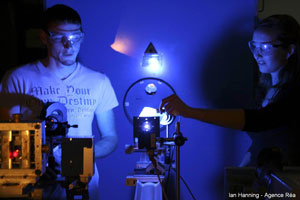Access Facilities - LP3 , Marseille – France
 |
Contact: Olivier Uteza Email |
LP3 Institute (Lasers Plasmas and Photonic Processing) is a Joint Research Unit of Aix-Marseille University (AMU) and CNRS. LP3 is a multidisciplinary academic laboratory of excellence. Its major activities focus on: i) high power pulsed laser and secondary sources such as X-ray technologies and ii) basic and technological research of laser-matter interactions. More than 35 people are working at LP3 on lasermatter interaction and the development of related photonic processes. The main applications are related to microelectronics (silicon and organic), photovoltaic, optical devices, medical and sensing. The research activities are divided in five transversal research operations: 1) Laser, Optics and Matter, 2) Laser and Plasmas, 3) Laser and Nano-/Micro-Electronics, 4) Laser and Biophotonics and 5) Laser, Energy and Environment. LP3 has a large set of pulsed laser sources, from ns to fs, and from UV to near IR. It is also equipped for in-situ (high speed imaging, spectroscopy …) and ex-situ (SEM, AFM, confocal and optical microscopes, ellipsometer, SNOM-RAMAN …) characterization of laser matter interaction, plasmas and samples. These facilities allow LP3 researchers to perform complete studies from optimized laser source development to matter processing, sensing or imaging technologies. Among the 16 laser sources of LP3, it is worth noting that one is unique in the world: a 100 Hz – 10 TW- 25fs Ti:Sa laser (ASUR platform).
Excellence: Laser processing, Laser Induced Breakdown Spectroscopy (LIBS), Ultrafast Laser-Induced Damage (LIDT), Laser Induced Forward Transfer (LIFT), Laser Produced Nanoclusters, Laser Surface Nanostructuring, hard X ray secondary source for phase contrast imaging and pump and probe experiments.
Publications:
- Organic Solvent and Surfactant Free Fluorescent Organic Nanoparticles by Laser Ablation of Aggregation-Induced Enhanced Emission Dyes, C. Lim et al., Adv. Opt. Mat. 6, 1800164 (2018)
- Impact of the pulse contrast ratio on molybdenum Kα generation by ultrahigh intensity femtosecond laser solid interaction, Y. Azamoum et al., Scientific Reports 8, 4119 (2018)
- Crossing the threshold of ultrafast laser writing in bulk silicon, M. Chanal et al., Nature Com. 8, 773 (2017)
- Generating liquid nanojets from copper by dual laser irradiation for ultra-high resolution printing, Q. Li et al., Optics Express 25, 24164-24172 (2017)
- Ideal radiation source for plasma spectroscopy generated by laser ablation, J. Hermann et al., Phys. Rev. E 96, 053210 (2017).


